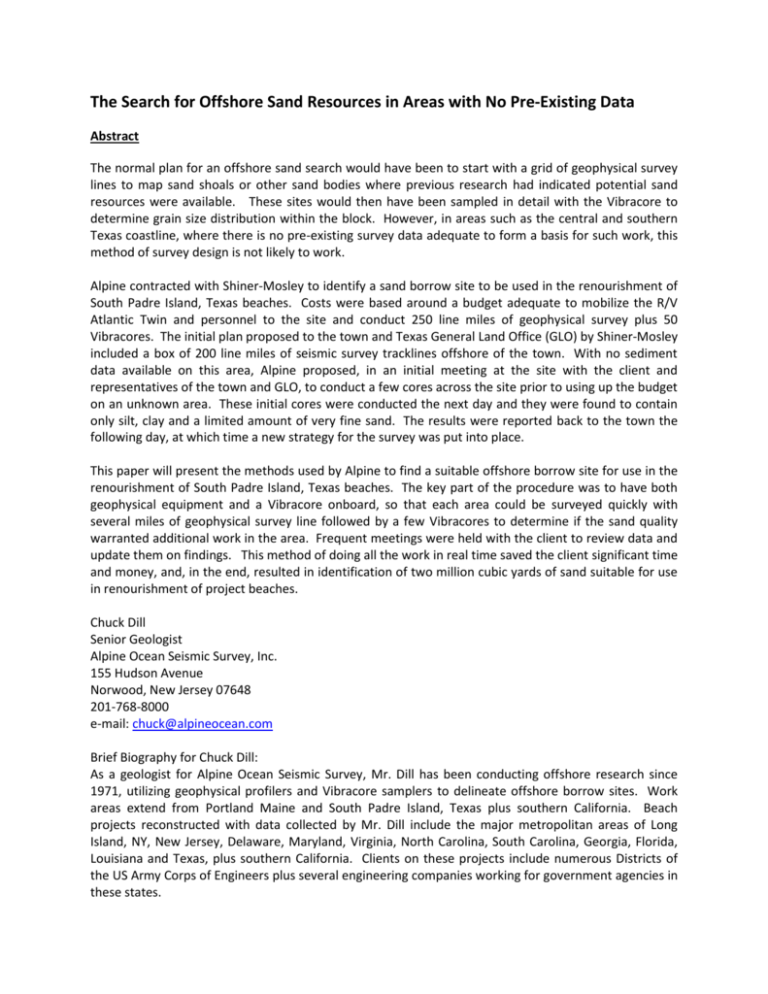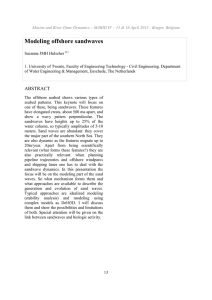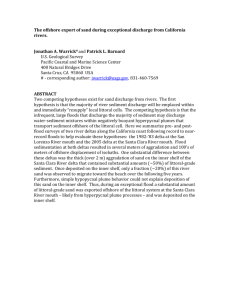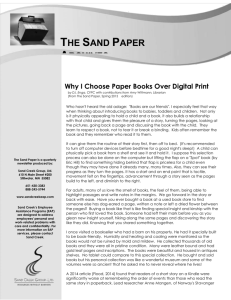The Search for Offshore Sand Resources in Areas with No Pre
advertisement

The Search for Offshore Sand Resources in Areas with No Pre-Existing Data Abstract The normal plan for an offshore sand search would have been to start with a grid of geophysical survey lines to map sand shoals or other sand bodies where previous research had indicated potential sand resources were available. These sites would then have been sampled in detail with the Vibracore to determine grain size distribution within the block. However, in areas such as the central and southern Texas coastline, where there is no pre-existing survey data adequate to form a basis for such work, this method of survey design is not likely to work. Alpine contracted with Shiner-Mosley to identify a sand borrow site to be used in the renourishment of South Padre Island, Texas beaches. Costs were based around a budget adequate to mobilize the R/V Atlantic Twin and personnel to the site and conduct 250 line miles of geophysical survey plus 50 Vibracores. The initial plan proposed to the town and Texas General Land Office (GLO) by Shiner-Mosley included a box of 200 line miles of seismic survey tracklines offshore of the town. With no sediment data available on this area, Alpine proposed, in an initial meeting at the site with the client and representatives of the town and GLO, to conduct a few cores across the site prior to using up the budget on an unknown area. These initial cores were conducted the next day and they were found to contain only silt, clay and a limited amount of very fine sand. The results were reported back to the town the following day, at which time a new strategy for the survey was put into place. This paper will present the methods used by Alpine to find a suitable offshore borrow site for use in the renourishment of South Padre Island, Texas beaches. The key part of the procedure was to have both geophysical equipment and a Vibracore onboard, so that each area could be surveyed quickly with several miles of geophysical survey line followed by a few Vibracores to determine if the sand quality warranted additional work in the area. Frequent meetings were held with the client to review data and update them on findings. This method of doing all the work in real time saved the client significant time and money, and, in the end, resulted in identification of two million cubic yards of sand suitable for use in renourishment of project beaches. Chuck Dill Senior Geologist Alpine Ocean Seismic Survey, Inc. 155 Hudson Avenue Norwood, New Jersey 07648 201-768-8000 e-mail: chuck@alpineocean.com Brief Biography for Chuck Dill: As a geologist for Alpine Ocean Seismic Survey, Mr. Dill has been conducting offshore research since 1971, utilizing geophysical profilers and Vibracore samplers to delineate offshore borrow sites. Work areas extend from Portland Maine and South Padre Island, Texas plus southern California. Beach projects reconstructed with data collected by Mr. Dill include the major metropolitan areas of Long Island, NY, New Jersey, Delaware, Maryland, Virginia, North Carolina, South Carolina, Georgia, Florida, Louisiana and Texas, plus southern California. Clients on these projects include numerous Districts of the US Army Corps of Engineers plus several engineering companies working for government agencies in these states.










